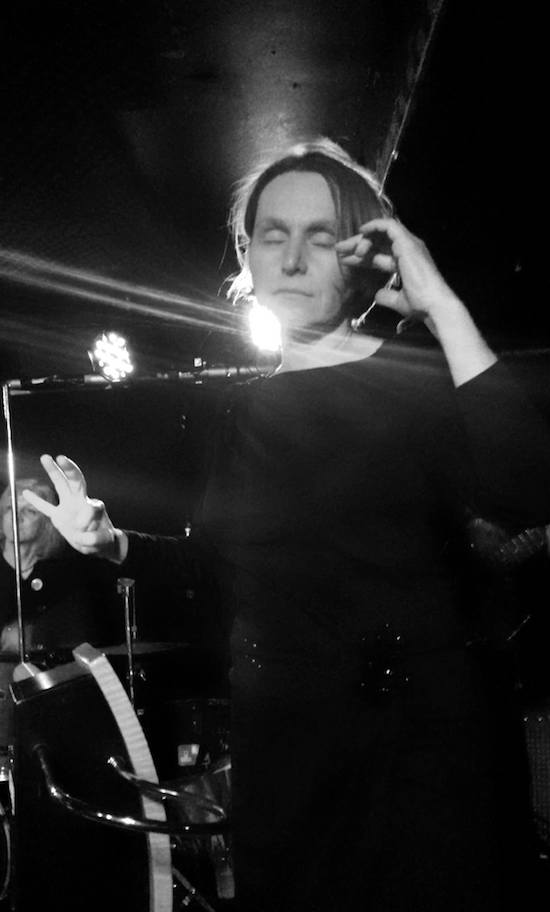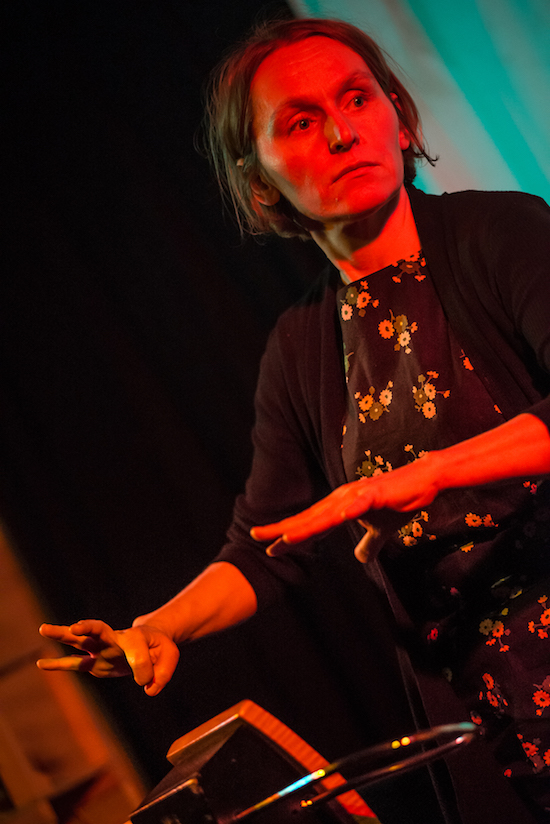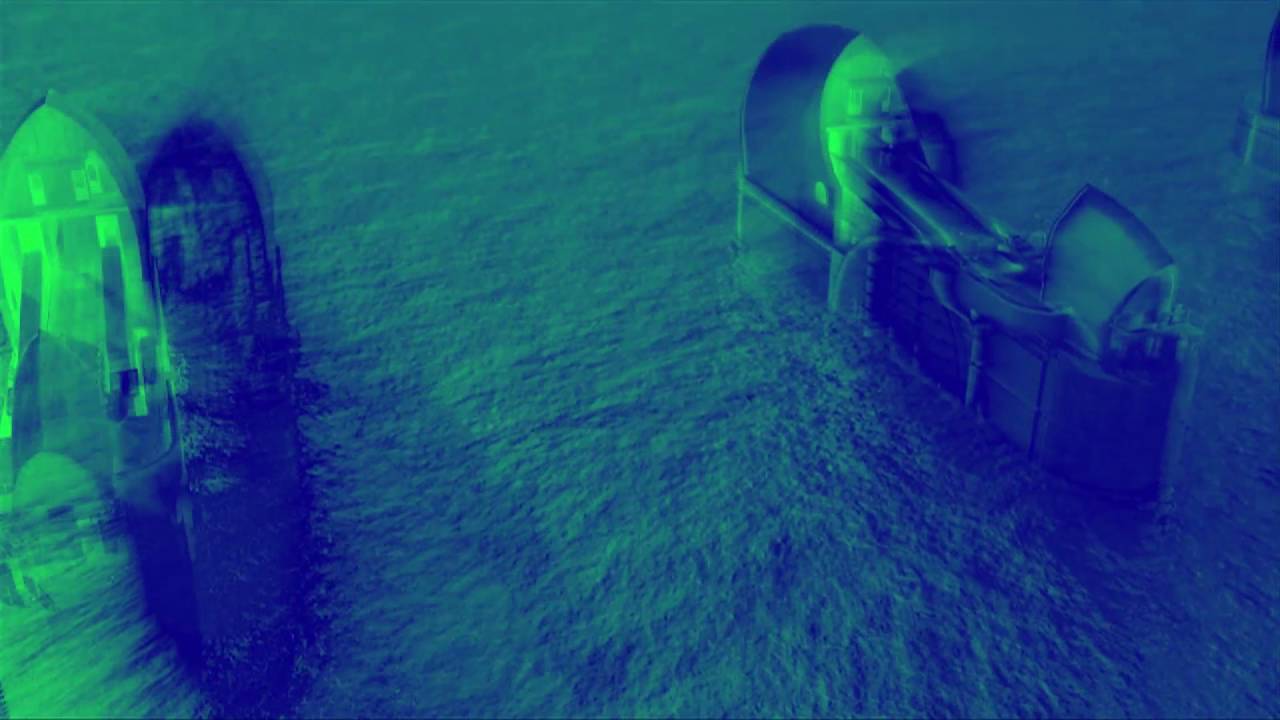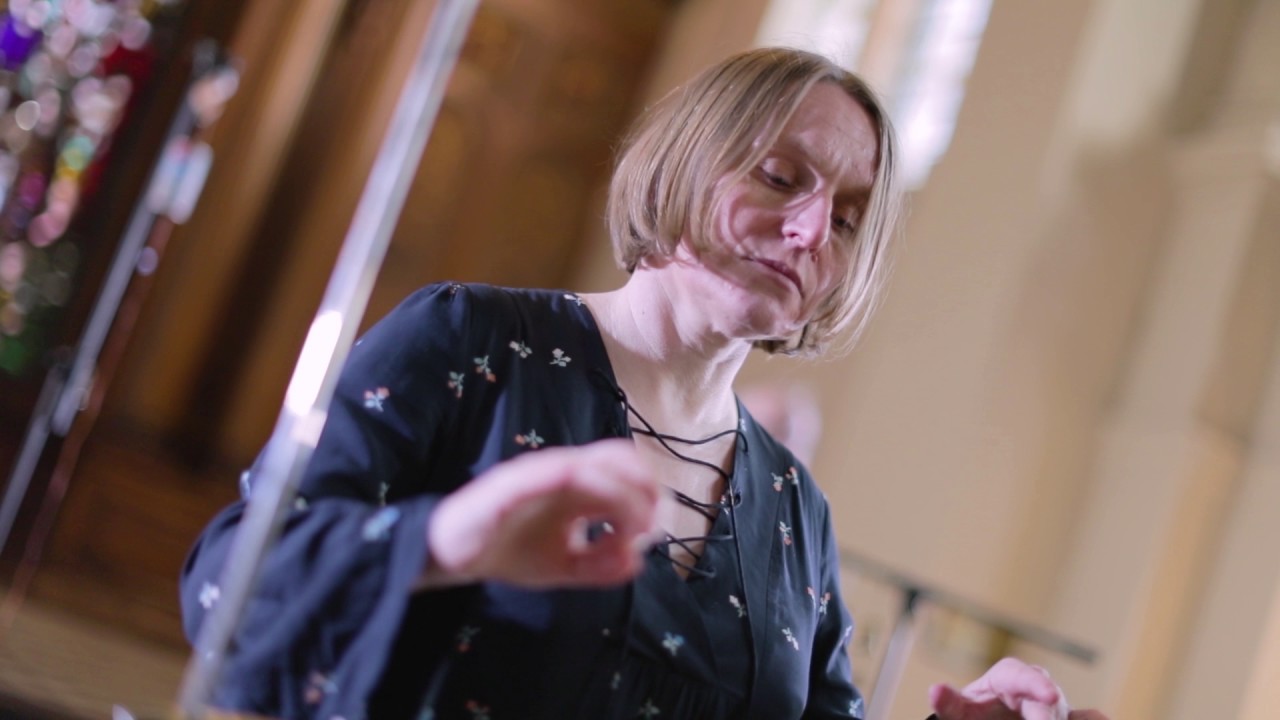Picture by Agata Urbaniak
Ever since Hugo’s head fell off and his teeth spilled across the stage, Sarah Angliss has been hesitant about bringing him on tour. The experimental musician has worked with a variety of collaborators over the years – as I speak to her on the phone, she’s building up to a performance at Supersonic festival, where she’ll be appearing as a trio with Sarah Gabriel (vocals) and Stephen Hiscock (percussion) – but her 1930s ventriloquist dummy head on a stick may not make the journey this time. “I worried that no one would enjoy the show without him,” she confesses, an anxiety belying the fact that her entire live show is extraordinary beyond Hugo.
Angliss’ work to date is staggering: as well as live and (recently) recorded music, she’s worked across theatre, cabaret, and film, is a Visiting Research Fellow at the Sound Practice Research Unit, Goldsmiths, and delivered a TEDx Talk in 2011 (with Caroline Radcliffe) about clog-dancing factory workers. In conversation, her mind seems to operate in a similar fashion to the industrial machines that fascinate her – ideas and impressions fly out at a million miles an hour, whizzing through the wires like electricity, often overlapping. “God, I’ve wittered on haven’t I?” she says at one point, and I suppose she has, but it’s all fascinating, articulate, driven. Like her career, it appears Angliss always carries a surplus of inspiration and ideas.
Following her 2017 solo album Ealing Feeder, Angliss has returned with another project inspired by her home city of London, Air Loom. By her own admission an artist who feels more at home on stage, it’s perhaps fitting that Angliss has taken a long time to commit her work to record – a lover of weird and wonderful instruments and tech, she nonetheless remains curious about humanity’s need to detach the voice from its corporeal form. I did it anyway.
I watched your TedTalk this morning, which I appreciate was recorded eight years ago now, but it appeared to me that some of the ideas about our relationship with technology and the noise of an industrial city still run through your work. What I found really interesting is that there’s so much talk about the anxiety of living alongside technology, whereas your work seems to look at ways of co-existing alongside technology.
Sarah Angliss: For me it was about women finding autonomy and expression in the face of the machine, but also coalescing with the machine, not escaping it. I’m one of those weird people who lived in London for years and years, and then I moved away, and immediately couldn’t wait to get back. I don’t want to escape any more than those women did, because they found their expression through the machine.
Rather than finding the eerie in the countryside, or some kind of bucolic paradise, I’m interested in the re-enchantment of the city, understanding the city. With technology, you’ve probably gathered I’m obsessed with telephony and everything related to communication. I’m fascinated with the enchantment of the telephone, for example: the idea that you can transmit a voice to a loved one instantaneously, without wires. We were talking about this the other day in relation to a ghost story we were working on. I don’t know if you heard about what happened during the Haiti earthquake?
I remember seeing it on the news…
SA: It was a horrible thing, of course. And one of the many horrors was that the phone network went down. Several hours later it rebooted people started getting SMS messages – and of course you couldn’t discern if it was a message from the living or the dead. We’ve forgotten how strange it is, these forms of technology, how they remake the corporeal envelope and really ask us to define where our boundaries are as humans. It can lead you to all sorts of strange places.
And this was all very common talk in the late 19th century, the early days of tech. If you look at that song ‘The Messenger’, those are direct quotations from an engineer writing at the end of the 19th century about imagining what a mobile phone would be like. And the line I missed out, because it felt too on the nose, was, ‘You may call and no reply will come. And then you will know your friend is dead, and it will feel like ghost world.’ To me, we’ve become inured to the strangeness of listening to the dead in our earbuds, listening to Elvis. How weird is that, that we don’t think anything of listening to the dead? If you described that to somebody two centuries ago it would have blown their mind! I suppose I’m just fascinated by how, whenever a new technology comes along, it challenges some primal feelings we have about this world and what’s beyond this world; who we are and what extensions our body might carry. I love all that stuff, that these folkloric ideas are made concrete in technology. I’m very much an urbanite – and a cyborg I suppose. Sometimes I can’t articulate it, but I hope the music can.
Are those ideas still prevalent in Air Loom?
SA: Well I don’t think they ever really go away. With the track ‘Raven’, which Sarah Gabriel is singing on, I was thinking about Odin’s ravens, travelling the world and knowing the fates of all people. There’s this wonderful idea of these birds travelling in an invisible ship that was a piece of cloth that folded into itself. To me that’s wireless comms. I love writing things when you can’t parse them, you don’t quite know what they are. I loved the idea of something that could be a love song, and there’s a certain melancholy to it, but there’s also an element of a curse to it, trying to tame somebody who’s always in flight, never on the end of the phone. I think those ideas sort of percolate through my music. It’s not technology for its own sake – as I say, I like the re-enchantment of tech around us. I find it hard to explain, which is why I put it in music. It’s oblique, like little shivers of something that you feel sometimes. If you’ve ever lost a loved one, the day when you wash your mobile phone by accident and lose all their text messages is a really significant day, and it feels like you’ve lost part of them. And that is very recognisable thing that people have shared – this idea that the body has become more than a fleshy envelope, in a way that’s quite exciting and also quite eerie. Some Americans are keeping their mobile contracts going after death and having their number put on the grave. I thought that’s very telling of how we feel about the augmentation of these technologies in a really quite profound way.
I’ve become very interested in the other side of memorialising that goes on in the music industry, which is the tribute act. If you’re a Bowie tribute act, for example, and then you continue after your hero dies, I find that very interesting, a sort of aural transmission of that person’s identity. And then it occurred to me that there’s such a melancholy in being the imitator, because it’s never going to be perfect, and yet you know what perfection is. My next album is the impossible album, because you could never afford to perform it, but the idea is to get all these kind of voices who are close facsimiles of certain people and think: how would they express their own melancholy and their own joy in their position? Songs of their own, but in the voice of the person they imitate. I thought that would be a really interesting album – but then my next thought was that I could never afford to perform it, because you’d have to get all these impersonators in, and I’m sure they cost a lot more than the rest of us put together!
It’s interesting to me because there are moments of real calm and beauty on Air Loom, especially on tracks like ‘Wan’, and then elsewhere moments that are quite cold and unsettling. Do you see those two modes working in unison in some ways?
SA: So the track ‘Wan’, for example, is an English folk song that I’ve had in my bones since I was a kid, because my earliest days of performing were in folk clubs. It’s exactly the kind of folk song I love: it beguiles you because it has the most exquisite melody, and so it slips under the skin. Your antennae aren’t out. And as you’re in the middle of the song, singing or listening to it, you realise it’s about an absolute horror. It’s like putting your hand on something soft and then realising it’s maggots. ‘Lucy Wan’, if you listen closely, is this sort of primal horror that everyone understands. What is the mother doing in that song, for example? What’s going on between the mother and the son? Because she should be dealing with the son, but she actually tries to protect him from the father. There’s a lot of really strange things in that song.
The thing about ‘Lucy Wan’ is it’s the best kind of melody, because it’s Lydian and it doesn’t ever settle anywhere. It’s restless because it doesn’t have a centre. It’s an ancient song, one of the oldest songs we know, and it’s almost like it’s sounding an alarm: there’s a wrongness in this. You don’t need to have thrashing things to create a sense of unease. Sometimes it’s the stillness in the music that tells you everything about the terror.
I wanted to talk a little bit though about movie scores, because presumably unlike most albums, you’ve got a pre-defined concept to work around, a work of art you want your art to wrap around. Is that the case?
SA: I’ve just been working on my first ever feature film score, so I’m learning on the job right now! Funnily enough it’s a contained horror set within London, so it’s got all the hallmarks that suit me. The director got in touch with me because she was interested in the folkloric, or the idea of the folkloric punching through to today, which is very much what the film is about. Once we agreed on the sound world it’s all just sort of fallen into place, because I think the film suits the kind of music I make anyway. I love John Carpenter, but it wasn’t a Carpenter-esque score she was after. I was trying to present music that felt like it could have come from the 12th century – or yesterday. I think that fits in with the timelessness of certain horror scenes.
The stranger one for me has been working in theatre. I loved working in theatre, but sound is still ancillary. But as concert performers, we know that you can have nothing going on except sound and it can completely electrify the room. So what I’ve found I’m having to do is still work with these wonderful directors, but also try and carve out my own work. I’m working with a brilliant director, Sarah Fahie, and we’re trying to bypass the traditional method where the director goes to the scenic director in the first instance, and look at what happens when the director and composer sit down together: what kind of theatre would they make?
As I say we’re starting with a ghost story, because whenever people want to do ghost stories they tend to want to do Dickensian things. I went to see this Dickensian ghost story the other day, and to make it scary, the actor kept adding an extra vowel onto everything: “And so-ah! As the little girl-ah…” It was distancing you by putting on all this Victorian bollocks. So what we’re trying to create is something like those songs – something that feels very ancient punching through to today.
Do you still prefer the experimental possibilities of live performance to recording an album?
SA: For me, although I’ve detoured into theatre, I am a live performer. If you notice, it took me years and years to get any album out at all, because I was convinced that my music wouldn’t ever translate to a CD or download; to me it was all about the physicality of me and the instruments and the other musicians. And so I engineered those tracks from the ground up to be performed live. To me every performance is a piece of theatre its own right, and I can’t explain it any other way. I’m very interested in people seeing the nuts and bolts of how those strange sounds on the album are made with their own eyes. I just think it’s electrifying performing live, and I think if I just retreated into the studio I think I’d lose my identity, because a lot of what I do is extemporise. It would lose that alertness.
But I’m in this weird set-up where I make very complex music that’s not laptop-based, but made with all these ridiculous instruments, some of which I’ve made myself and which are very shonky. So I’m trying to think about what to do for the next year, and try to do something a little pared back. I’ve got three years of blessed relief from financial worries after getting this Paul Hamlyn Award money – they’ve basically given me three years of money to experiment – and what I want to try and do is create an album that could be toured on the train. Two or three musicians on the train with a suitcase each. I can’t imagine myself doing it, but I want to try.
And what about the visual element of performing on stage? I notice your stage companion Hugo is still joining you on stage…
SA: Well I don’t know if he is! This is very interesting. Have you ever seen the film Dead Of Night? It’s this whole thing about this man and and his obsession with this dummy. In the early days of performing, including quite a bit on the cabaret circuit, I ended up with Hugo. He ended up becoming so popular that I began feeling I was using it as an emotional crutch: “if Hugo’s not there they’ll all hate it!” And then when Air Loom came out – this is absolutely true – I didn’t write anything for Hugo, and there was a big hoo-ha about whether we should engineer him into some of these pieces. I was adamant that we shouldn’t.
Anyway, we were in Glasgow on the very first night having the discussion, and I said, “Well, I just don’t think we need him.” And I swear to you, as I finished those words Hugo’s table fell over, he landed on the stage and all his teeth fell out.
That’s so freaky.
SA: It was very freaky. And then we had to take him apart, which was even freakier. So then he was out of the set, which was good, and I found I could do the whole of Air Loom without Hugo and nobody missed him. After that my other half Colin sawed Hugo’s head off to get to the teeth, because they’d gone down his throat, and as he sawed it off we saw the label inside. Now here’s the really freaky bit: it was made by Quisto who, if you’re into ventriloquist dummies, you know he made all of these dummies in the 30s in London. And Hugo was made one street away from where I’m living now, you can practically see the place from the garden. So he was made in about 1937 I think, and that house was bombed out during the war, so it’s now a block of flats. So I just think it’s really strange that he’s come back to where he was made. Now it’s in the balance and I genuinely don’t know whether to bring him or not. It sounds really screwed up!
You’ve described sound making devices as potentially counter-cultural objects. Could you elaborate on that idea?
SA: I was doing some stuff for the science museum on the history of sound culture. I was with Karina Townsend, who’s this really talented musician, at this exhibition where everyone was talking about the old VCS 3s in such hushed, reverential tones. “Where are you on the waiting list?” blah blah blah. On the way home we were laughing, because there’s one in that college and they chucked it out, or so and so’s got that and they rescued it from the skip. So I was very interested in the way that the perceived value of objects ebb and flow. It’s interesting because if you look at music at the turn of the 20th century, there was a certain cultural conservatism. I feel it going on now with people who disdain the city and disdain tech, like if you retreat into the woods you’re somehow more authentic as an artist. It’s just not me – I tried living in the countryside and it was the most traumatic year of my life, I couldn’t wait to get back!
For me what was interesting was that, in the early music revival, people were going to instruments like the viola da gamba and early recorders, and there were very expensive makers who were making them. It was a very middle class pursuit. “I’ve got a viola da gamba, it’s so much harder to pitch than the modern cello because it’s so special” etc. And of course the music that it made was beautiful as well, but it was also like these instruments were punching above their weight because it was a moralistic thing. And when I hear about the vintage synth revival, I’m hearing echoes of that. I love analogue, but I don’t attach any moral weight to the decision one way or another, I basically just use whatever works. I found that the parallels between the long waiting list in the 20th century and the long waiting list in the 21st century because of the cultural baggage of an instrument were utterly fascinating. Those objects were treated as being counter-cultural, but it’s just a very refined consumerism isn’t it? So it’s interesting when all these cheapo versions are made, because it’s kind of democratising. If you want the sound, you can get it cheap without having to join the club. I think that’s very exciting.

Photograph by Lucy Cage
Do you still listen to a lot of new music? Are you a fan of artists like Holly Herndon?
SA: What I find most exciting about Holly Herndon at the moment is that she’s breaking away from the laptop and bringing physicality into the performance. Because I always think the laptop is a wonderful garden, but if you hop over the hedge there’s this whole world out there, and to me it’s very exciting that she’s now hopped over the hedge. I absolutely love what she’s doing, and what I like about her stuff is the same thing I love about music: getting inside sound. So it’s not about harmonic complexity but sonic complexity, excavating sound, opening it up and stretching it like liquorice. I think she’s very exciting.
I tell you who else I find interesting at the moment, and I don’t know her from Adam other than the fact that she’s done videos round the corner from where I live, and that’s Farai. A million miles away from the music I make, and I cannot explain why I love it, but I think it’s startling. It’s music that startles you, and it’s of the city, and completely its own voice. There’s two songs I particularly love, ‘Lion Warrior’, which is about being a global citizen in the city, and ‘This Is England’ which is going to be sort of out of date soon because it’s essentially a message to Theresa May as Prime Minister. I found that one because I live in Southwark and I’m sure you know there’s a lot of politicking going on with certain estates being decanted with unaffordable ‘affordable’ housing, so I’ve been following all that, and very particularly what’s been going on with the shopkeepers in Elephant, where we’ve got this brilliant Latin-American community who are very anxious to make sure they’re being treated fairly when all the new development comes in. Someone sent me the ‘This Is England’ video because it’s filmed round the corner from where I live, and I just think she’s brilliant.
I saw you mentioned a summer composition prospect with a string quartet on Twitter, is that something you can talk about yet?
SA: Well because I’ve been doing this film with a lot of strings in it, I’m itching now to write some stuff for strings. I’ve had this idea that’s been on the back-burner for ages, and it’s partly based on a book I’m obsessed with, Magic In Modern London by Edward Lovett. I’m also just really into writing for strings at the moment and I’ve realised it’s something I want to explore. Also with this imaginary album I discussed, this fantasy football album with the Dusty Springfield impersonator and the David Bowie impersonator and so on, I feel like I would want it to have a certain dignity about it, and that seemed to make sense. As I say I’m so, so lucky to have this Hamlyn money, because it means I can take a few weeks out and try stuff like that. Had I not got that I’d be foraging around now for anything that moved to keep me going, because it’s always been a little hand to mouth.
What else are you working on?
I made a music video for ‘Dust’ because I had a horrible feeling that the moon landing anniversary was going to be marked by jingoistic bands who take soundbites of particular bits of history and then play guitar riffs under them. Oh god, I can imagine the concert now, and there’s going to be a laser beam, and it’s going to be fucking depressing! So I kind of wanted to write an antidote in advance so I could just park it there and get it off my chest, this contemplative thing about the transcendental nature of the moon. But what was lovely was that a young filmmaker, Tom Hadrill, made a really lovely video for it. That track’s really strung out, but I think it works.




